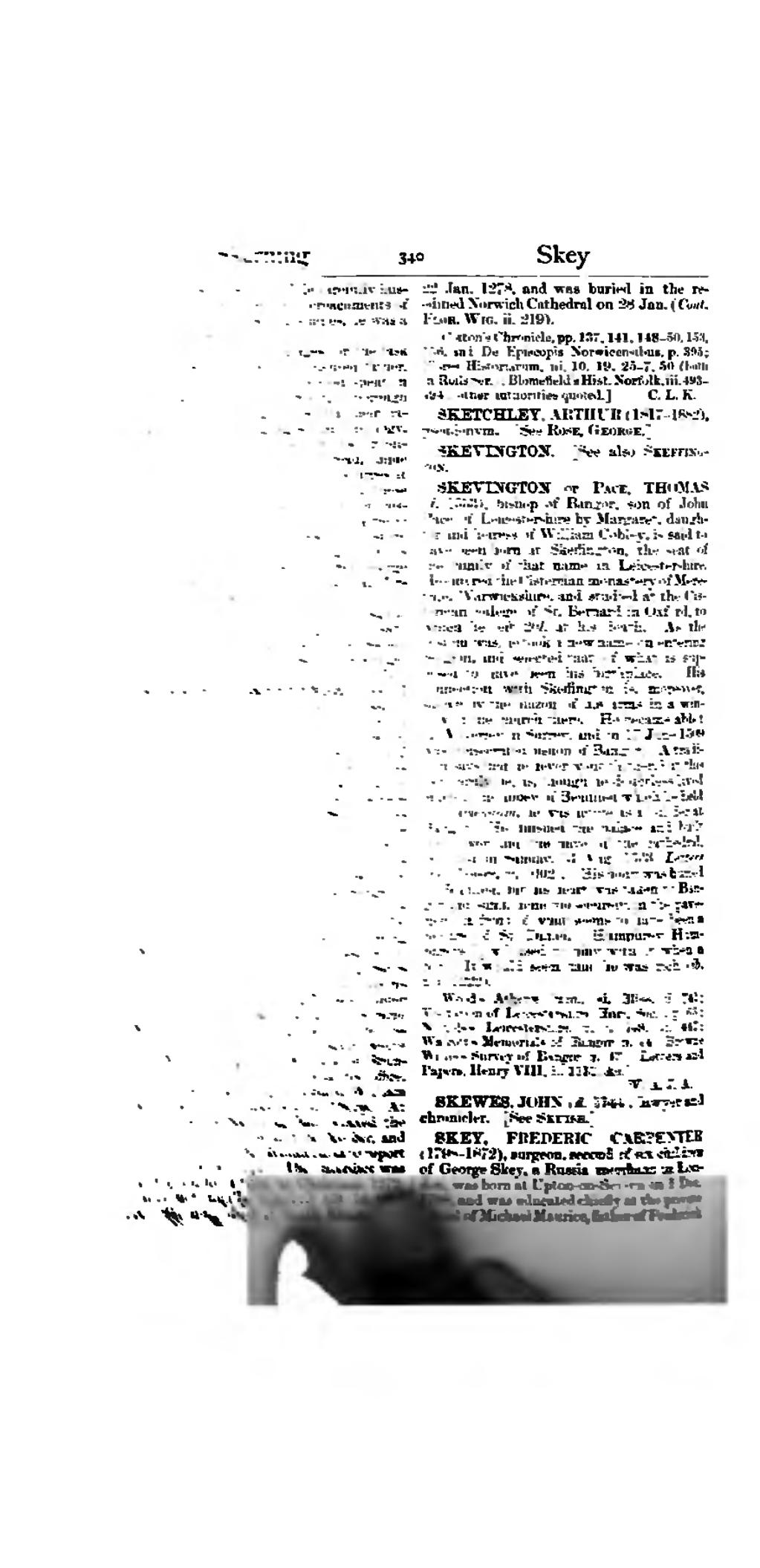and judicious adviser. While carefully husbanding his time from the encroachments of society for his duties and studies, he was a hospitable host.
Skene had many advantages for the task of a Scottish historian: a talented father, an intellectual home, a boyhood spent in the atmosphere of Walter Scott, a thorough knowledge of the Highlands and their natives, a taste for languages and philology, especially Celtic, with opportunities for cultivating it both at home and abroad, ample preparation by the study of Celtic sources at first hand, and a long life. Yet all these would not have sufficed had he not possessed an historic instinct and a patriotic desire to enlarge the boundaries of the history of Scotland and throw new light on its darkest age. His portrait, by Sir George Reid, P.R.S.A., is now in the National Portrait Gallery of Scotland.
[Skene's Memorials of the Family of Skene, published by the New Spalding Club, 1887; obituary notice in Proceedings of the Society of Scottish Antiquaries; personal knowledge; and private information.]
SKERNING or SKERVINGE, ROGER de (d. 1278), bishop of Norwich, possibly took his name from Scarning in Norfolk. Becoming a Benedictine monk of Norwich, he was elected prior of his house in 1257 (Cotton, p. 137). On 23 Jan. 1266 he was chosen bishop of Norwich; he received the royal assent on 9 Feb., the temporalities were restored on 17 March, and on 19 Sept. he was consecrated by the legate Ottobon at Canterbury (Le Neve, Fasti Eccl. Angl. ii. 461). On 16 Dec. 1266 ‘the Disinherited’ then holding out in the Isle of Ely took Norwich by storm, and Skerning had to seek refuge at Bury St. Edmunds (Memorials of St. Edmund's Abbey, vol. ii. p. xxxvi, iii. 31). The great event of his episcopate was the burning of Norwich Cathedral and monastery by rioters on 11 Aug. 1272. On 29 Aug. Skerning held an assembly at Eye, and excommunicated the rioters, putting Norwich under an interdict. On 14 Sept. King Henry came to Norwich to hold an inquiry into the disturbance, and stayed with the bishop twelve days. As a consequence William de Brunham the prior was removed from his office, and on 1 Oct. Skerning confirmed William de Kyrkely as his successor at Thorp. At the king's wish Skerning had relaxed the interdict, but he renewed it in October, and sent messengers to the Roman curia to report the matter to the pope. The interdict was relaxed again for a time at Christmas 1272, but was not finally removed till 15 Oct. 1275. Skerning died at South Elmham on 22 Jan. 1278, and was buried in the re-edified Norwich Cathedral on 28 Jan. (Cont. Flor. Wig. ii. 219).
[Cotton's Chronicle, pp. 137, 141, 148–50, 153, 156, and De Episcopis Norwicensibus, p. 395; Flores Historiarum, iii. 10, 19, 25–7, 50 (both in Rolls Ser.); Blomefield's Hist. Norfolk, iii. 493–494; other authorities quoted.]
SKETCHLEY, ARTHUR (1817–1882), pseudonym. [See Rose, George.]
SKEVINGTON. [See also Skeffington.]
SKEVINGTON or Pace, THOMAS (d. 1533), bishop of Bangor, son of John Pace of Leicestershire by Margaret, daughter and heiress of William Cobley, is said to have been born at Skeffington, the seat of the family of that name in Leicestershire. He entered the Cistercian monastery of Merevale, Warwickshire, and studied at the Cistercian college of St. Bernard in Oxford, to which he left 20l. at his death. As the custom was, he took a new name on entering religion, and selected that of what is supposed to have been his birthplace. His connection with Skeffington is, moreover, shown by the blazon of his arms in a window of the church there. He became abbot of Waverley in Surrey, and on 17 June 1509 was consecrated bishop of Bangor. A tradition says that he never went thither, but this can hardly be, as, though he doubtless lived much at the abbey of Beaulieu which he held in commendam, he was active as a builder at Bangor. He finished the palace and built the tower and the nave of the cathedral. He died on Sunday, 13 Aug. 1533 (Letters and Papers, vi. 1002). His body was buried at Beaulieu, but his heart was taken to Bangor and sunk, none too securely, in the pavement in front of what seems to have been a picture of St. Daniel. Humphrey Humphreys [q. v.] used to play with it when a boy. It would seem that he was rich (ib. xiv. 1222).
[Wood's Athenæ Oxon., ed. Bliss, ii. 741; Visitation of Leicestershire (Harl. Soc.), p. 63; Nichols's Leicestershire, II. i. 548, iii. 447; Walcott's Memorials of Bangor, p. 44; Browne Willis's Survey of Bangor, p. 97; Letters and Papers, Henry VIII, ii. 1131, &c.]
SKEWES, JOHN (d. 1544), lawyer and chronicler. [See Skuish.]
SKEY, FREDERIC CARPENTER (1798–1872), surgeon, second of six children of George Skey, a Russia merchant in London, was born at Upton-on-Severn on 1 Dec. 1798, and was educated chiefly at the private school of Michael Maurice, father of Frederick
